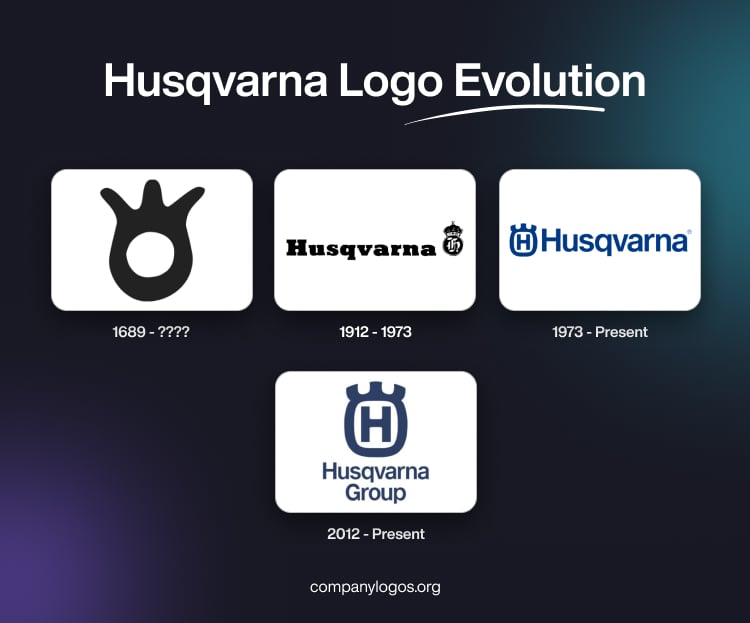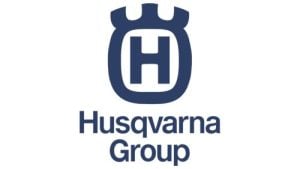
Husqvarna is arguably one of the oldest operating companies in the world, which came into existence in 1689 in Sweden. Initially, the company used to produce muskets for the Swedish Army but is now reputed as the producer of several types of lawnmowers, garden tools, small tractors, chainsaws, cultivators, and motorcycles.
The story of the Husqvarna logo begins in 1689; it was founded in Huskvarna, Sweden, as a royal arms factory. This heritage has directly inspired the brand’s iconic logo, which to this day represents a stylised gun sight viewed from the end of a barrel. The logo iterations showcase the company’s remarkable multi-sectoral journey as a manufacturer. The article explores the various changes undertaken by the Husqvarna logo, among other details of the company.
The Genesis of the Husqvarna Logo (1689 – ????)
The company was established in 1689 to produce muskets. So, the logo too featured a circle with a crown above it to showcase its role in serving as a Royal Arms Factory. The logo encapsulated the muzzle of a musket, a bullet protecting the throne, and the royal ring, which acted as permission by the king. It appeared like a rounded seal with three protruding lines to symbolise a crown.

(1912 – 1973)
The 1912 logo iteration featured an emblem and the wordmark in a title case and in an extra-bold serif typeface. The emblem constituted a circle with a crown atop it. The circle had a monogram inside with a gothic-style appearance that symbolised the legacy of the company.

(1973 – Present)
In 1973, the logo was modernised by adopting a blue, stylised crown with an “H” at the centre. The word “Husqvarna” appeared beneath or to the right of the emblem in a crisp, title-case sans-serif font. This version paid homage to the original 1689 brand while bringing a sleeker and more contemporary look. The blue-and-white palette conveyed reliability, trust, and professionalism.

(2012 – Present)
In the current logo iteration, the colours changed to a slightly darker blue. The wordmark too was changed to “Husqvarna Group” and presented across two lines under the crown. This enhanced the sense of modernity and sophistication and signalled the global ambitions of the company.

The Elements of the Husqvarna Logo
Font
The current logotype uses a bold, clear sans-serif typeface, which is similar to Sequel Sans or Shapiro Max Heavy. This gives off a sense of strength and dependability.
Colour
Deep blue and white are used for most Husqvarna products to convey protection and reliability. Some divisions, like outdoor power tools, have embraced vibrant oranges and greys. Here, orange signifies energy and innovation, while grey signifies stability and wisdom.
The History of Husqvarna
The history of Husqvarna can be traced back to 1689, when it was established as a weapons factory by the waterfalls in Huskvarna, southern Sweden (originally spelt Husqvarna), to manufacture firearms for the Swedish army. This origin set the stage for Husqvarna’s expansive legacy as one of the world’s oldest continuously operating companies.
It took advantage of local metalworking expertise that dated back to the Rumlaborg fortress from the 14th century. Through the 18th century, the factory focused almost exclusively on making muskets and rifles. It grew into a major employer in the region and became an important part of Sweden’s industrial landscape.
After the mid-1800s, Husqvarna began a process of diversification as contracts for weapons dwindled. Applying their precision engineering skills to civilian industries, the company changed course to produce sewing machines in 1872. It did so by repurposing its rifle-making machinery for the new line. In 1874, the company expanded yet again and started producing kitchen equipment such as cast iron stoves and ovens. The following decades saw the introduction of bicycles by 1896, Swedish typewriters by 1895, and a range of kitchen appliances and meat mincers. These developments underscored Husqvarna’s adaptability and inventive spirit.
In 1903, Husqvarna entered the motorcycle market with its first motorised bicycle. This marked the beginning of more than a century of continuous two-wheel manufacturing and innovation. The brand would soon become synonymous with high-performance motorcycles, especially contributing to motorsport heritage with models like the Silverpilen (“Silver Arrow”).
Throughout the 20th century, Husqvarna motorcycles distinguished themselves in both competitive and recreational arenas. In the process, they gathered numerous accolades in motocross and enduro racing to cement the brand’s international reputation for quality and rugged engineering.
Husqvarna’s innovative drive extended into the outdoor power equipment sector during the 20th century as well. The company launched its first chainsaw in 1959 and became a leader in the field with further introductions such as engine-driven lawnmowers. Always striving for technological advancements, Husqvarna pioneered features like reduced noise and vibration in chainsaws and, in 1995, introduced the world’s first solar-powered robotic lawnmower, the Automower. The decades that followed included expansion into brushcutters and snowblowers. These innovations demonstrated an ongoing commitment to innovation in outdoor and home equipment.
From 1978 until 2006, Husqvarna operated as part of Electrolux, which enabled it to expand its global reach, particularly in the outdoor power tool market. The company regained its independence in 2006 and emerged as a publicly traded entity once again. The subsequent years saw Husqvarna make strategic acquisitions, such as Gardena in 2007, which was the leading consumer watering-products brand in Europe, and Jenn Feng in 2008, which helped expand operations into Asia. Investments like the 2013 development of a new chainsaw chain manufacturing facility in Huskvarna reinforced the company’s Swedish roots.
Meanwhile, Husqvarna’s motorcycle division also experienced significant changes. After being sold to Italian firm Cagiva in 1987, and following the departure of its core team to found Husaberg in Sweden, the motorcycle brand passed into the hands of Austria’s KTM Group (Pierre Mobility AG) in 2013. As of today, Husqvarna Motorcycles holds a respected position in global motorcycling. It produces competitive off-road, enduro, and urban bikes for a modern audience.
Recent years have been marked by further innovation and diversification. In 2022, Husqvarna unveiled the CEORA satellite-guided robotic lawnmower for large-scale, industrial applications. This signalled a bold move in automation and smart technology. The company expanded its capabilities in smart irrigation by acquiring ETWater in 2024. It also embraced e-mobility by offering electric bicycles and motorcycles to meet emerging environmental and market trends.
Over its evolution from royal arms maker to an international leader in outdoor products and motorcycling, Husqvarna has demonstrated remarkable resilience and adaptability. The company has continued to emphasise quality craftsmanship and technological innovation. In fact, the company’s Swedish heritage is encapsulated by its enduring “crown and gun sight” logo. Husqvarna’s legacy is defined by its ability to honour its origins while relentlessly reinventing itself to meet the demands of changing times.
Interesting Facts About Husqvarna
- Husqvarna started as a royal arms manufacturer in 1689 to produce muskets for the Swedish army.
- The company logo, featuring a gunsight viewed from the end of a barrel, reflects its origins in firearms production.
- Husqvarna has evolved drastically, and it manufactures everything from sewing machines and stoves to motorcycles and chainsaws.
- It entered the lawn and garden equipment industry in the early 20th century and is now a global leader in this space.
- Husqvarna began producing motorcycles in 1903, which makes it one of the oldest motorcycle brands in the world.
- The brand gained fame in motocross and enduro racing, especially in the 1960s and 1970s, when it won numerous world championships.
- Husqvarna is a pioneer in robotic lawn care, for it launched the world’s first robotic lawn mower (Automower) in 1995. In fact, the latest models of the lawnmower include GPS navigation, smartphone control, and AI capabilities.
- Husqvarna introduced its first chainsaw in 1959. Known for innovation, it has developed anti-vibration technology and noise-reduction systems that are now industry standards.
- Legendary motorcyclist Steve McQueen was a fan and racer of Husqvarna motorcycles in the 1960s and 70s.
- The brand still has a strong presence in motocross and supermoto sports today under Pierre Mobility (which also owns KTM).
- Today, Husqvarna Group and Husqvarna Motorcycles are separate entities. Thus, the Husqvarna Group focuses on outdoor power products like lawn mowers, chainsaws, and garden tools. On the other hand, Husqvarna Motorcycles is part of Pierre Mobility Group, which is based in Austria.
- Husqvarna products are sold in over 100 countries. It is a market leader in forest and garden products in Europe and holds a strong position globally.
- The company has a strong focus on eco-friendly innovation, including battery-powered equipment, low-emission engines, and sustainable production practices.
Finally
The Husqvarna logo iterations weave together three centuries of history by honouring its origins in firearm production. The logos also show its adaptation to a future focused on innovation and global brand identity. Thus, what began as a simple mark on a musket is now a globally recognised emblem. It embodies craftsmanship, quality, and a rich Swedish legacy.